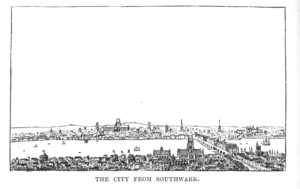Coldharbour, City of London facts for kids
Coldharbour was the name for two old estates (like large properties) in London. They were located in an area called Dowgate Ward, which is part of the City of London today. For hundreds of years, from the 1200s to the mid-1600s, Coldharbour was situated near the Thames River, close to where Cannon Street station is now. It was sadly destroyed in the Great Fire of London in 1666. One of these estates was once used by important people like the Dukes of Exeter and even briefly as a special school for heralds (people who study coats of arms and family histories).
A Glimpse into Coldharbour's Past
Coldharbour was once a "liberty," which meant it had its own special rules and was not fully under the control of the City of London. This changed in 1608 when King James I made it part of the City's official area.
The Famous Coldharbour House
Coldharbour House was a large, grand house from the Middle Ages. It stood right on the north bank of the River Thames, just a little bit upstream from the old London Bridge and near where Cannon Street station is now.
This important house was located on Upper Thames Street, a narrow road along the river. Many other wealthy noblemen also had their big houses there. The first time Coldharbour House was mentioned was during the time of King Edward II. It belonged to a knight named Sir John Abel.
Owners Through the Ages
In 1334, a rich merchant named Sir John de Pulteney bought the house. He was a very important person, serving as the Lord Mayor of London four times in the 1330s! Because of him, the house became known as Pulteney's Inn.
Later, in the late 1300s, the house belonged to John Holland, 1st Duke of Exeter. He was a half-brother to King Richard II, and the King even visited him at Coldharbour House!
In 1410, King Henry IV gave the property to his son, who would later become King Henry V. Years later, King Richard III gave Coldharbour House to the College of Arms. This college was a group that studied family histories and coats of arms, and they used the house to store their important records and for people to live in.
However, King Henry VII took the house back from the college. He then gave it to his own mother, Lady Margaret Beaufort. After that, the house became the property of the Earls of Shrewsbury, and its name was changed to Shrewsbury House.
Coldharbour House was either taken apart by the 6th Earl of Shrewsbury or destroyed during the terrible Great Fire of London in 1666. Even though the original house was gone, a new building with the same name was built on the same spot. This later building was used as the hall for the Company of Watermen and Lightermen (a group of people who worked on the river) until 1778.



